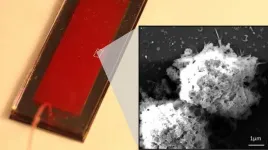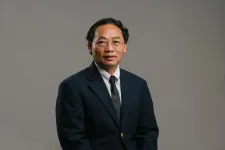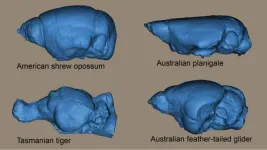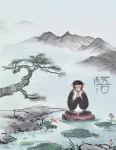(Press-News.org) Knowing how to predict the specific composition and cell design that would result in optimum performance is one of the greatest unresolved problems in materials science. This is, in part, due to the fact that the device performance depends on multiple factors.
Now, researchers from the Institute of Materials Science of Barcelona, specialized on materials for energy applications, have collaborated with researchers from the Universitat Rovira i Virgili specialized in Artificial Intelligence, to combine the experimental data points that they gather with artificial intelligence algorithms and enable an unprecedented predicting capability of the performance of organic solar cells.
ICMAB researchers, led by Mariano Campoy-Quiles, have generated multiple data sets by using a new experimental method that allows them to have a large number of samples in only one, speeding the time compared to conventional methods. Then, machine-learning models are used to learn from those data sets and predict the performance of even more materials, such as novel organic semiconductors synthetized at the group of Prof. Martin Heeney at Imperial College London.
This study may be the first of many in the field combining artificial intelligence and high-throughput experiments to predict the optimum conditions of certain materials and devices.
Obtaining multiple experimental data points
One of the key aspects of this study is that researchers are able to generate big and meaningful datasets at minimal experimental effort. This is an important aspect toward the success of machine-learning modelling in order to obtain accurate and reliable models and predictions.
Researchers use a methodology based on combinatorial screening in which they generate samples with gradients in the parameters that mostly affect the performance of organic solar cells (i.e. composition and thickness).
"When using a conventional method, a sample provides you with information about only one point. However, using our methodology we can obtain between 10 and 1000 times more points. This allows, on the one hand, to evaluate the photovoltaic potential of a material about 50 times faster than with conventional methods. On the other hand, it provides large statistics and a huge set of data (hundreds of thousands of points) that allow us to reliably train different artificial intelligence algorithms" says Mariano Campoy-Quiles, ICMAB researcher and co-author of this study.
Artificial Intelligence algorithms to predict the behavior
"Within the broad field of AI, in this work we apply machine-learning, which is a term that gathers all sort of algorithms which confer machines (i.e. computers) the ability to learn from a given set of data, yet not necessarily to take autonomous decisions. Here, we exploit the more statistical vision of AI to draw predictive models from our large experimental datasets" explains Xabier Rodríguez- Martínez, ICMAB researcher and first author of the study.
Artificial intelligence algorithms in the field of materials science are mainly used to look for behavior patterns and to further develop predictive models of the behavior of a family of materials for a given application. To do so, an algorithm is first trained by exposing it to real data to generate a model algorithm. The model is then validated with other data points not used to create the model, but from the same category of materials. Once validated, the algorithm is applied to predict the behavior of other similar materials that are not part of the training nor validating set.
In this specific study, AI algorithms are trained with thousands of points obtained with the high throughput method to evaluate and predict the different factors that determine the efficiency of an organic solar cell.
Achievements and future challenges
This work represents two great achievements. On the one hand, developing AI models that predict how efficiency depends on many of the organic solar cell parameters. The degree of prediction is very high even for materials that have not been used in the training set.
"The second important point is that thanks to AI, we have determined which are the physical parameters that affect to a greater extent this behavior" says Mariano Campoy-Quiles, and adds "In particular, we have seen that the most critical parameters that determine the optimum composition are the electronic gap of each material, as well as how balanced the charge transport is in each one."
Researchers believe that the results and the methodology developed in this study are very important to guide theoretical researchers as to what to take into account when developing future analytical models that attempt to determine the efficiency of a given system.
"Our next challenge is to understand much more complex systems. The more complex the system, the more useful AI can be" concludes Campoy-Quiles.
INFORMATION:
Reference:
Xabier Rodríguez-Martínez, Enrique Pascual-San-José, Zhuping Fei, Martin Heeney, Roger Guimerà and Mariano Campoy-Quiles. Predicting the photocurrent-composition dependence in organic solar cells. Energy & Environmental Science, 2021, DOI: 10.1039/D0EE02958K
Building on the promise of emerging therapies to deploy the body's "natural killer" immune cells to fight cancer, researchers at the University of Michigan Rogel Cancer Center and U-M College of Engineering have gone one step further.
They've developed what is believed to be the first systematic way to catch natural killer cells and get them to release cancer-killing packets called exosomes. These nano-scale exosomes are thousands of times smaller than natural killer cells -- or NK cells for short -- and thus better able to penetrate cancer cells' defenses.
A proof-of-concept study in blood samples from five patients with non-small cell lung cancer demonstrated that the approach was able to capture natural killer cells on a microfluidic ...
Paris, France, January 27th 2021 -- COVID-19 vaccine distribution has begun across the globe, while many countries are still struggling with the rampant rise of infections. Owkin, a French-American startup pioneering AI and Federated Learning in medical research, has been focusing it's COVID-19 research efforts on aspects of the pandemic that still require much public health attention, despite the arrival of an effective vaccine.
Efforts to support frontline health systems as they devote their resources to the influx of COVID-19 related hospitalizations, ...
Seawater makes up about 96% of all water on earth, making it a tempting resource to meet the world's growing need for clean drinking water and carbon-free energy. And scientists already have the technical ability to both desalinate seawater and split it to produce hydrogen, which is in demand as a source of clean energy.
But existing methods require multiple steps performed at high temperatures over a lengthy period of time in order to produce a catalyst with the needed efficiency. That requires substantial amounts of energy and drives up the cost.
Researchers from the University of Houston have reported an oxygen evolving catalyst that takes just minutes to grow at room temperature on commercially available nickel foam. ...
Mason scientists employ a rapid-result, saliva-based test that significantly expands testing capacity, and an antibody test that can track vaccine response.
George Mason University announces it is introducing a rapid-result, saliva-based COVID-19 test that will greatly expand testing capabilities on its campuses this spring. The effort, led by Mason's faculty, is part of a comprehensive program to better track and control the virus on campus.
Mason scientists, who are pushing the boundaries of technologies that are keeping Mason's campuses safe, are ...
The main culprit in cancer is healthy cells that have gone rogue and acquire the ability to divide uncontrollably. These cells acquire growth advantages over normal cells and manipulate their environment by altering the cellular pathways involved in growth and metabolism. Over the past few decades, various altered pathways and proteins have been identified as targets for therapeutic interventions. However, what remains challenging is selectively targeting cancer cells and ensuring that the drug reaches the tumor in adequate amounts, without severely affecting normal cells. And in this regard, biocompatible delivery vehicles (which are non-toxic to normal cells) can be useful.
One such potential candidate is "porphyrins," a group of organic cyclic compounds that form the ...
Being stretchy and squeezable may be the key to finding space for the brain in mammals, including humans.
An international study, co-led by Flinders University's Vera Weisbecker, has revealed that marsupial mammals like possums, kangaroos, and wombats appear to have a lot of flexibility when it comes to accommodating their brains into their skulls.
"The brain is one of the heaviest parts of the head, particularly in smaller mammals. But it needs to be placed in a way that doesn't interfere with the many vital functions of the head, such as seeing, hearing, smelling and of course feeding," says Dr. Weisbecker.
"Stowing" a large brain ...
WASHINGTON -- Researchers have developed a new approach that improves the image quality and contrast for holographic displays. The new technology could help improve near-eye displays used for virtual and augmented reality applications.
"Augmented and virtual reality systems are poised to have a transformative impact on our society by providing a seamless interface between a user and the digital world," said research team member Jonghyun Kim from technology company NVIDIA and Stanford University. "Holographic displays could overcome some of the biggest ...
(Singapore--January 28, 2021 11:00 p.m. SPT/10:00 a.m. EST)----Several leading international lung cancer researchers at a press briefing held by the International Association for the Study of Lung Cancer today, presented compelling new data revealing that factors of race, gender, sexual orientation and income continue to be significant barriers to those living with lung cancer. The press briefing is part of the IASLC's World Conference on Lung Cancer 2020 Singapore.
The press briefing is moderated by IASLC Communications Committee Chair Dr. Anne-Marie Baird, senior research fellow at Trinity College in ...
Clear rules for engineering transgenes that can be inserted and propagated over multiple generations of nematodes include ways to protect inserted genes from the organism's natural defenses against foreign DNA. Developed by KAUST researchers, the rules have implications for many research fields, including gene therapy development.
Scientists often study biological processes, such as normal and mutant gene functions, in the worm Caenorhabditis elegans because it has many genes and molecular pathways in common with humans. Specific gene functions can be investigated by injecting DNA into the worm's reproductive organs, where it links into what is known as an extra-chromosomal array. This array is eventually incorporated into the nucleus, where it is duplicated ...
A team led by Prof. SU Bing from the Kunming Institute of Zoology (KIZ) of the Chinese Academy of Sciences (CAS), Prof. LI Cheng from Peking University, and Prof. ZHANG Shihua from the Academy of Mathematics and Systems Science of CAS has reported the highest resolution by far of the 3D genome of the primate brain, and demonstrated the molecular regulatory mechanisms of human brain evolution through cross-species multi-omics analysis and experimental validation. The study was published in Cell.
The unique pattern of human brain development stems from accumulated genetic changes during human evolution. Among the huge number of diverging genetic changes, only a small portion of the between-species ...





